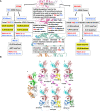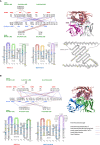3D structures inferred from cDNA clones identify the CD1D-Restricted γδ T cell receptor in dromedaries
- PMID: 36016959
- PMCID: PMC9396240
- DOI: 10.3389/fimmu.2022.928860
3D structures inferred from cDNA clones identify the CD1D-Restricted γδ T cell receptor in dromedaries
Abstract
The Camelidae species occupy an important immunological niche within the humoral as well as cell mediated immune response. Although recent studies have highlighted that the somatic hypermutation (SHM) shapes the T cell receptor gamma (TRG) and delta (TRD) repertoire in Camelus dromedarius, it is still unclear how γδ T cells use the TRG/TRD receptors and their respective variable V-GAMMA and V-DELTA domains to recognize antigen in an antibody-like fashion. Here we report about 3D structural analyses of the human and dromedary γδ T cell receptor. First, we have estimated the interaction energies at the interface within the human crystallized paired TRG/TRD chains and quantified interaction energies within the same human TRG/TRD chains in complex with the CD1D, an RPI-MH1-LIKE antigen presenting glycoprotein. Then, we used the human TRG/TRD-CD1D complex as template for the 3D structure of the dromedary TRG/TRD-CD1D complex and for guiding the 3D human/dromedary comparative analysis. The choice of mutated TRG alternatively combined with mutated TRD cDNA clones originating from the spleen of one single dromedary was crucial to quantify the strength of the interactions at the protein-protein interface between the paired C. dromedarius TRG and TRD V-domains and between the C. dromedarius TRG/TRD V-domains and CD1D G-domains. Interacting amino acids located in the V-domain Complementarity Determining Regions (CDR) and Framework Regions (FR) according to the IMGT unique numbering for V-domains were identified. The resulting 3D dromedary TRG V-GAMMA combined with TRD V-DELTA protein complexes allowed to deduce the most stable gamma/delta chains pairings and to propose a candidate CD1D-restricted γδ T cell receptor complex.
Keywords: 3D modelization; Camelus dromedarius; IMGT unique numbering; T cell receptor; TRG and TRD loci; multiple sequence alignments (MSA).
Copyright © 2022 Linguiti, Tragni, Pierri, Massari, Lefranc, Antonacci and Ciccarese.
Conflict of interest statement
The authors declare that the research was conducted in the absence of any commercial or financial relationships that could be construed as a potential conflict of interest.
Figures




References
Publication types
MeSH terms
Substances
LinkOut - more resources
Full Text Sources

